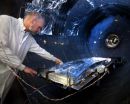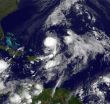(Press-News.org) COLUMBIA, Mo. – Diagnostic ultrasounds are the most widely used medical tests in the world. Though the technology is more than 50 years old, scientists continue to discover new uses for it, ranging from more targeted cancer treatments to liposuction. As the technology becomes more complex, a sonographer's skill level is even more important. Now, researchers at the University of Missouri may have found one of the keys to becoming a successful sonographer: spatial ability.
Doug Clem, clinical assistant professor of MU's diagnostic ultrasound program in the MU School of Health Professions, led the study of ultrasound students' spatial abilities. The study is the first to show how students' spatial abilities correlated to their results on scanning proficiency tests. Spatial ability is the ability to process and understand physical relationships among objects. This is important in sonography because ultrasounds are not like other medical tests, such as x-rays or CT scans. A sonographer cannot capture the entire object at once, but instead must collect a series of images and assemble them into a logical sequential order for a physician to read.
"It's operator dependent," said Sharlette Anderson, clinical instructor of MU's diagnostic ultrasound program. "I can scan the entire liver, but I'm not giving the radiologist images of every millimeter of the liver. I am giving him specific images and anything that I see that looks abnormal. If I miss an abnormality, the radiologist never sees it and the diagnosis is missed."
The study tested first-year ultrasound students' spatial abilities prior to any major coursework. Then, scientists tracked students' results on standard scanning proficiency tests over two semesters. Initially, the study showed little association between spatial ability and scanning proficiency. However, by the end of the academic year, students with greater spatial abilities were much more likely to have scored high on scanning tests.
Clem sees spatial ability tests as a potential consideration for admission to a sonography program. Currently, the program uses academic criteria like grade point average and ACT scores to evaluate undergraduate applications. Other professions, including dentistry and engineering, have used spatial ability testing for years. Spatial ability is affected by genetics, but recent research has shown that individuals can improve their spatial ability. Participating in certain hobbies, such as playing video games, working puzzles and other similar activities can encourage spatial ability development.
"Even though you may be a really strong academic student, you may not learn to scan as easily as other people might." Clem says. "Some of our best students, straight-A students, will need extra time or extra clinical time to get past their scanning competency tests. This poses a challenge for selecting the best candidates for admission, and we think that spatial ability testing may turn out be one more piece of the puzzle that is needed to select the right individual."
The study was published in the Journal of Diagnostic Medical Sonography. Clem worked with Anderson and Moses Hdeib, director of the diagnostic ultrasound program. The team has started a second study, in cooperation with several universities, community colleges and proprietary schools from across the country. Through this larger study, Clem hopes to further validate the results of the first study by increasing the number of students observed. Depending on the results of the second study, the department will consider changing admission requirements next summer.
INFORMATION:
Improving sonography requires improving sonography school admissions
University of Missouri researchers find key characteristic for growing field
2010-10-10
ELSE PRESS RELEASES FROM THIS DATE:
Webb Telescope sunshield passes launch depressurization tests to verify flight design
2010-10-10
NASA's James Webb Space Telescope continues to make significant progress, successfully completing a series of sunshield vent tests that validate the telescope's sunshield design.
"While adequate venting is a design consideration for all spaceflight hardware, this was a particularly unique challenge for the sunshield given the large volume of trapped air in the membrane system at launch," said Keith Parrish, Webb telescope sunshield manager at NASA's Goddard Space Flight Center in Greenbelt, Md. "From the beginning of its development venting features have been a critical ...
Women's race and class impact contraception recommendations, UCSF study shows
2010-10-10
A woman's race/ethnicity and socioeconomic status impact whether health care providers recommend one of the most highly effective forms of contraception, a UCSF study confirms. The results also indicate that the interaction of both factors plays a role in clinicians' decisions.
Recommendations by health care providers previously have been found to vary by patients' race and socioeconomic status, contributing to health disparities, according to the researchers. The team investigated the effect of these factors on recommendations for contraception.
Study results appear ...
Alienated youths are more likely to lash out
2010-10-10
When people are rejected by peers, they often lash out. In children, that aggression occasionally takes horrifying directions, leading to school shootings or other deadly acts. Researchers in the Netherlands found that some children are more likely than others to lash out in response to acute peer rejection: children who already feel like outcasts.
"It was inspired by the fact that we had these school shootings and wondered what the most important feature of these kids could be," says Albert Reijntjes of Utrecht University, who cowrote the study with five other psychological ...
Researchers discover a new class of highly electronegative chemical species
2010-10-10
RICHMOND, Va. (Oct. 8, 2010) – An international team of researchers has discovered a new class of highly electronegative chemical species called hyperhalogens, which use superhalogens as building blocks around a metal atom. The new chemical species may have application in many industries.
Researchers from Virginia Commonwealth University, McNeese State University in Lake Charles, La., and the University of Konstanz in Germany report their discovery in the Oct. 6 international chemistry journal Angewandte Chemie International Edition. The journal designated the paper as ...
NASA sees Otto become eighth hurricane of the Atlantic season
2010-10-10
At 11 a.m. EDT on Oct. 8, Otto strengthened into a hurricane, becoming the eighth hurricane of the Atlantic Ocean season. NASA's Aqua satellite and the NOAA GOES-13 satellite captured images of Otto as he intensified.
Otto had maximum sustained winds near 75 mph, and the National Hurricane Center in Miami, Fla. noted that some strengthening is possible before it weakens on Saturday, Oct. 9. Otto was located about 445 miles south of Bermuda near 25.9 North and 64.0 West. It was moving east-northeast near 17 mph, and had a minimum central pressure of 979 millibars.
On ...
NASA's Mobile Mars Laboratory almost ready for flight
2010-10-10
The Sample Analysis at Mars (SAM) instrument suite has completed assembly at NASA's Goddard Space Flight Center in Greenbelt, Md., and is nearly ready for a December delivery to NASA's Jet Propulsion Laboratory (JPL), Pasadena, Calif., where it will be joined to the Curiosity rover. SAM and Curiosity are set to fly on the on the upcoming Mars Science Laboratory (MSL) rover mission scheduled for launch in the fall of 2011.
SAM will become an automated, mobile laboratory as it is carried across Mars by the rover when the mission arrives at the Red Planet in 2012. Together ...
UT Southwestern researchers create experimental vaccine against Alzheimer's
2010-10-10
DALLAS – Oct. 12, 2010 – Researchers at UT Southwestern Medical Center have created an experimental vaccine against beta-amyloid, the small protein that forms plaques in the brain and is believed to contribute to the development of Alzheimer's disease.
Compared with similar so-called DNA vaccines that the UT Southwestern researchers tested in an animal study, the new experimental vaccine stimulated more than 10 times as many antibodies that bind to and eliminate beta-amyloid. The results appeared in the journal Vaccine.
Future studies will focus on determining the ...
Clue to unusual drug-resistant breast cancers found
2010-10-10
Researchers at the University of Illinois at Chicago College of Medicine have found how gene expression that may contribute to drug resistance is ramped up in unusual types of breast tumors. Their findings may offer new therapy targets.
The study is published in the Oct. 8 issue of the Journal of Biological Chemistry, where it is designated a paper of the week.
Approximately 70 percent of breast cancers express the estrogen receptor. These "ER-positive" tumors usually respond to hormone-related therapies, such as tamoxifen or aromatase inhibitors. But not always.
"We ...
Progress toward first commercial repellent for East Coast's stinker
2010-10-10
WASHINGTON, Oct. 9, 2010 — Help may be on the way for millions of people on the East Coast bugged out about the invasion of stink bugs. Scientists have reported a key advance in efforts to develop the first commercial repellent for stinkbugs, which are emerging as a major nuisance to homeowners and a devastating pest to some farm crops. They identified a natural substance in a fungus that infects a common weed and found that it shows potential as the first stinkbug repellent. Their study appeared in ACS' bi-weekly Journal of Agricultural and Food Chemistry.
Hiromitsu ...
Clinical trials demonstrate effective weight loss strategies for obese and overweight adults
2010-10-10
CHICAGO -- Lifestyle interventions, including physical activity and structured weight loss programs, can result in significant weight loss for overweight, obese and severely obese adults, according to two reports that were posted online today by JAMA. The studies and accompanying editorials were made available early online to coincide with the presentation of these papers at the 28th Annual Scientific Meeting of the Obesity Society. The articles will appear in the October 27 print issue of JAMA.
According to background information in the papers, obesity is among the ...
LAST 30 PRESS RELEASES:
UC Riverside scientists win 2025 Buchalter Cosmology Prize
SETI Institute opens call for nominations for the 2026 Tarter Award
Novel theranostic model shows curative potential for gastric and pancreatic tumors
How beige fat keeps blood pressure in check
Fossils reveal ‘latitudinal traps’ that increased extinction risk for marine species
Review: The opportunities and risks of AI in mental health research and care
New map reveals features of Antarctic’s ice-covered landscape
Beige fat promotes healthy vascular function and blood pressure in mice
Chronic low-dose pesticide exposure reduces the life span of wild lake fish, China-based study shows
Tiny earthquakes reveal hidden faults under Northern California
Long-term pesticide exposure accelerates aging and shortens lifespan in fish
Professor Tae-Woo Lee's research group develops groundbreaking perovskite display technology demonstrating the highest efficiency and industry-level operational lifetime
The “broker” family helps tidy up the cell
Ecology: Mummified cheetahs discovery gives hope for species’ Arabic reintroduction
Researchers survey the ADHD coaching boom
Air pollution and cardiac remodeling and function in patients with breast cancer
Risk of suicide in patients with traumatic injuries
Post–intensive care syndrome
The lifesaving potential of opioid abatement funds
The Frontiers of Knowledge Award goes to Allan MacDonald and Pablo Jarillo-Herrero for their discovery of the “magic angle” enabling science to transform and control the behavior of new materials
Discovery reveals how keto diet can prevent seizures when drugs fail
JMIR Publications and Sikt announce pilot flat-fee unlimited open access partnership
Finding new cell markers to track the most aggressive breast cancer in blood
A new, cleaner way to make this common fertilizer
Fire-safe all-solid-state batteries move closer to commercialization
Disinfecting drinking water produces potentially toxic byproducts — new AI model is helping to identify them
Unplanned cesarean deliveries linked to higher risk of acute psychological stress after childbirth
Healthy aging 2026: fresh pork in plant-forward diets supported strength and brain-health biomarkers in older adults
Scientists identify pre-cancerous states in seemingly normal aging tissues
Itaconate modifications: mechanisms and applications
[Press-News.org] Improving sonography requires improving sonography school admissionsUniversity of Missouri researchers find key characteristic for growing field



